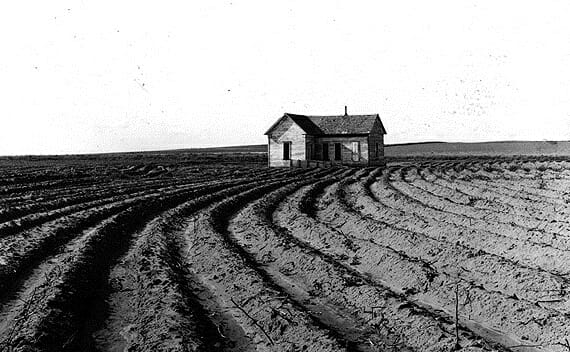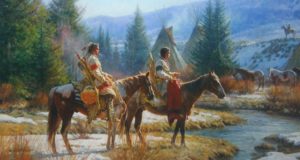When the stock market crashed in October of 1929, it sent the country into a tailspin and resulted in an economic depression that would last 10 years. Although no sector of the American economy was immune to the fallout, the agricultural community was hit especially hard.
For most farms, the depression actually began just a few years after the end of World War I. During the war the government had pushed farmers to grow and produce as much as possible to send overseas to troops and to export to European nations. However, once the war ended and other countries were able to get their own agriculture back on their feet, prices went into sharp decline here. Suddenly there was far more product than demand, causing farmers often to sell at a loss. Still, credit was easily available and farmers were able to limp along in hopes that the market would stabilize.
When the stock market crashed, though, all the “limping along” came to a sudden stop. Banks became desperate as depositors removed their funds, forcing the banks to call in their loans and mortgages. For farmers who had already been struggling with variable markets, this often meant foreclosure and bankruptcy sales.
Get Free Backup Electricity — That Works Even During Blackouts!
Still, a number of farmers both big and small were able to carry on. Those who avoided foreclosure and bankruptcy now dealt with the next hurtle – very few had the funds to buy their products! Supply exceeded demand in such extremes that by the early 1930s corn was worth less than coal, just 5 to 10 cents a bushel. Many farmers turned to burning corn to heat their homes.
Despite low prices and a stagnant market, farmers who had been able to hold onto their lands were much better off than many of the people who lived in town. Those who farmed were able to grow food and to feed their families, even when there was no money to be had. Neighbors got together and traded crops and livestock, and for this reason more small farms and farming communities faired far better than the bulk of town dwellers.
In 1933 Congress passed the Agricultural Adjustment Act to aid struggling farm families. This Act raised farm product prices by paying farmers not to raise crops or livestock, particularly corn and hogs. By the end of that same year the government controlled 87 percent of corn and 95 percent of hog production.
In the Midwest and Plains states, trouble continued to brew. Dust storms had begun to crop up as early as 1931. Farm lands which had been over plowed during the farming boom of the early part of the century had turned dry due to drought. These dust storms worsened and increased over the next few years, and by 1934 about 35 million acres of land that had been previously cultivated was now useless. Another estimated 125 million acres was losing its topsoil at a rate that would soon make it useless, as well.
Farmers who had held on now found themselves in a new situation. Many abandoned the land and migrated in hopes of finding jobs or land to rebuild. Those who stayed dealt with health issues such as “dust pneumonia” and the persistent dust and dirt that found its way into every nook and cranny. After several major dust storms in 1934 and 1935, the term “Dust Bowl” was coined.
In 1935, Congress established the Soil Erosion Service, along with the Prairie States Forestry Project. These were just two of several programs that FDR and Congress started in hopes of reducing the strain and addressing the plight of the American farmer. The Prairie States Forestry Project was one of several that put unemployed farmers to work, planting trees and windbreaks to help slow the windstorms and erosion.
While the Heartland tried to halt the loss of its topsoil, the Dakotas and areas to the north were fighting grasshoppers. The grasshopper plague as it was later called caused not only the loss of crops, but destroyed trees and just about anything the bugs could eat. Many farmers, tired of poor prices, drought, and insatiable insects, left and headed west in search of other opportunities.
Meanwhile, in other parts of the country, small farms and farming communities that had been able to survive on their own were now finding some growing market for their crops and livestock in local towns and cities. Town dwellers, who had previously not had cash to buy with, now were able to afford a little after FDR’s “New Deal” put men back to work building bridges and other infrastructure.
In the latter part of the 1930s the rains returned and with it the end of the “Dust Bowl” storms. Many people who had migrated out of the Heartland returned to their farming lifestyle, though others had to adjust crops and change techniques due to the erosion of topsoil.
With the onset of World War II, agriculture in the U.S. finally recovered as once again American began exporting crops to European nations. It also marked the end of the Great Depression, as factories once more began to produce goods.
What would you add? Share your thoughts in the section below:
 Off The Grid News Better Ideas For Off The Grid Living
Off The Grid News Better Ideas For Off The Grid Living




